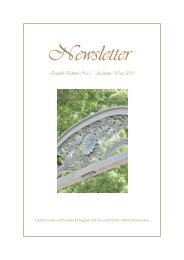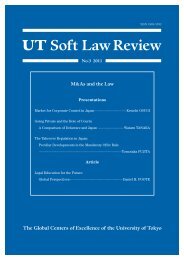<strong>UT</strong> <strong>Soft</strong> <strong>Law</strong> <strong>Review</strong> No.2 2010the issue, the “independent committee” (also called the “special committee” or the “thirdpartycommittee”) that consists of outside directors (if any), outside auditors,and outsideintellectuals is formed to advise the board of directors whether or not to implement thedefense measure, and the board, taking the advise into consideration, make the final decisionwhether or not to implement the defense measure.Corporate Value Study Group’s New Report (June 2008)Fujita: Thank you. The judicial precedents and the practice surrounding takeover defensehave evolved just like you said. The Corporate Value Study Group’s New Report, “TakeoverDefense Measures in Light of Recent Environment Changes,” discussing how takeoverdefense measures should be implemented, has lately attracted attention. Corporate ValueStudy Group is a private group that belong to Ministry of Economy, Trade and Industry,butit can be said that the group has a certain role in forming the rules for takeover defense. Forexample, after the Nippon Broadcasting System Case, Ministry of Economy, Trade andIndustry and Ministry of Justice jointly released the guideline (”Guidelines RegardingTakeover Defense for the Purposes of Protection and Enhancement of Corporate value andshareholders’ common interests” (May 27,2005, Ministry of Economy, Trade and Industry/Ministry of Justice)), following the group’s report (Corporate Value Study Group “CorporateValue Report: Toward the Firm Establishment of Fair Rules in the Corporate Community”(May 27, 2005)). Professor Yamada, could you introduce the contents of the group’s newreport?Yamada: Well, I am not sure if I am the best person to introduce the Corporate ValueStudy Group’s New Report (June 2008) because there are several members of the group,including the chair person, but I guess I am in the most neutral position, so let me introducethe Corporate Value Study Group’s New Report (June 2008) itself briefly. The main purposeof the Corporate Value Study Group’s New Report (June 2008) is to outline the relationshipwith the past legal principle and precedents to suggest a reasonable takeover defense that theshareholders and the investors would ultimately understand and agree with.Now, the practical issue of takeover defense is that “(1) Granting cash or other financialbenefits to the acquirer would trigger the implementation of takeover defense, and, as aresult, while time, information and the negotiation opportunity required to appropriatelydecide whether or not to support the takeover are ensured, the opportunity to sell the stockto the acquirer would be lost, which could prevent the formation of an efficient capital market.Therefore, financial benefits should not be granted to the acquirer. (2) The argument thattakeover defense are always justified in so far as they are approved by a majority ofshareholders in the shareholders meeting, even though directors avoid making a decision ontheir own and pass on the decision to the formality of the shareholders’ meeting, might send awrong message to concerned parties that a concrete defense system can be established withthe shareholder structure, which would guarantee the approval of a resolution of the49
<strong>UT</strong> <strong>Soft</strong> <strong>Law</strong> <strong>Review</strong> No.2 2010shareholders meeting”The Corporate Value Study Group’s New Report (June 2008) outlines the past judicialprecedents, especially concentrating on the point whether takeover defense would improvethe common interest of the shareholders. The summary is as follows:Whether or not takeover defense will enhance the shareholders’ interests will differ ineach case, depending on their objectives and contents and on the characteristics of thetakeovers. Bearing this in mind, in order to deal with the issue of legality of takeover defense,it would be necessary to examine judicial decisions on the past cases, by focusing on theobjectives of takeover defense and how they are operated. As a result of such examination,takeover defense can be broadly categorized as follows:(1) Cases where adequate time and information is necessary for shareholders toappropriately decide whether or not to support the takeover, and opportunities fornegotiation between the acquirers and the target companies are ensured by takeoverdefense : Japan Engineering Consultants, Co., Ltd. Case (Tokyo High Court, July 29,2005)(2) Cases where takeover defense are implemented to stop the takeover based on thesubstantive judgment in view of the contents of the takeover’s proposal.Generally deterring takeovers by implementing takeover defense deprives shareholdersin favor of the takeover of the opportunities to sell their shares to the acquirers.Therefore, the implementation of takeover defense based on the substantive judgmentin view of the contents of the takeover proposals should, in principle, be limited. Basedon the examination of past judicial decisions, cases where such implementation wouldbe permitted would be categorized into the following two typical cases in accordancewith the characteristics of the acquirers and their behavior:(a) Cases where takeover defense are implemented against abusive takeovers, whichare clearly detrimental to the shareholders’ interest;Nippon Broadcasting System Inc. Case (Tokyo High Court, March 23, 2005)(b) Cases where takeover defense are implemented based on the substantivejudgment that the takeover proposals are detrimental to the shareholders’interest.Bull-Dog Source Case (Supreme Court, August 7, 2007)The group’s report evaluates each case in detail to see what procedure was taken toimplement the defense measure, or if the financial benefits is necessary or not. For detailedinformation, please see the Corporate Value Study Group’s New Report (June 2008).That’s all from me.Fujita: Thank you for your precise and concise summary. We will discuss the categories oftakeover defense measures in more detail later.Now, why this kind of report was released in this timing? Professor Kanda, can you give usyour comment as the chairperson of the Corporate Value Study Group, if you do not mind?50





